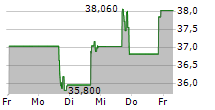
Integrating the physical toll of climate change helps investors spot key risks-and opportunities.
NORTHAMPTON, MA / ACCESSWIRE / November 1, 2024 / AllianceBernstein

Sara Rosner | Director of Environmental Research and Engagement
Markus Schneider | Senior Economist-EEMEA
Patrick O'Connell, CFA | Director-Fixed Income Responsible Investing Research
Zac Greear | Climate Research Analyst-Responsibility
Climate-focused investing traditionally emphasizes how well industries are transitioning to low-carbon economies, such as responding to climate-friendly regulations, greener technologies and shifting consumer needs. But transition risks and opportunities are just one of several lenses to assess climate change's impact on the investment landscape. Physical risks and opportunities are another.
Knowing Physical Threats Enhances Risk Assessment
The number of companies that acknowledge climate change's direct financial impact grew 24% in 2023, according to a CDP Worldwide survey. But transition risks continue to command more of companies' attention than physical risks. Between 2009 and 2020, for example, average mentions of transition risks in 10-K filings grew from four to 10, while average mentions of physical risks rose from two to just four, based on a Brookings Institute analysis. We think such low reporting for physical risks suggests that businesses are only beginning to appreciate their effect on the bottom line.
The threats are very real, however. Physical risks can be chronic-as with rising global temperatures and sea levels - or acute, as in the case of an extreme heatwave or a hurricane. Any of these can levy substantial financial burdens on businesses and global economic growth alike.
The financial toll of physical risks manifests in several ways, but often through local property damage or total loss. There are also costs for stranded or delayed production capacity, plant closures, supply chain disruptions and legal liabilities from not adapting assets and communities to be more resilient.
Disasters can also hurt local households, from job losses to residential displacement, which has implications for labor supply and customer demand for products and services. As these local extremes add up, their macro implications can throttle global productivity, trade and government revenues, as well as sway inflation and interest rates.
Physical Risks Won't Disappear, Prompting More Ways to Cope
As a global disruptor, climate change remains one of a handful of mega-forces likely to permanently change how the world lives, works and consumes - all directly affecting countries, assets and companies on many levels.
For example, population centers will likely shift within countries and across continents as crops fail or it becomes too hot to work outdoors. Agriculture-dependent regions could be the most vulnerable, not only to food scarcity but to modern slavery.
Emerging-market (EM) regions are especially vulnerable to physical risks-frequently the result of flooding or drought. Thankfully, we're seeing governments and the private sector deploying more coping mechanisms across these regions. These include adaptation plans, multi-hazard warning systems and risk assessments, which we believe help offset some of EM's high exposure to physical risk (Display). This suggests that even countries with high physical-risk potential could take effective steps to manage it - and improve creditworthiness.
Data Show Climate Change Is Global but Impact Is Local
Florida hurricanes, Canadian wildfires, Abu Dhabi flooding - when hazards strike, they're not only more frequent and costly but also hyper-regional. That's why we believe that understanding physical risks at the local level helps investors better assess their potential financial damage, even for globe-spanning entities.
Obtaining local physical-risk data can be challenging. In the US, some granularity can be mapped using the Natural Hazards Index (NHI), which AllianceBernstein developed in partnership with the Columbia Climate School. The index tracks 14 types of extreme-weather disasters and assigns risk scores to some 75,000 underlying census tracts. Meanwhile, the global Aqueduct Water Risk Atlas, which tracks potential water-specific risks, pinpoints areas facing the highest risks to potable water quality and quantity.
Another hurdle in evaluating physical risks is tying them to companies' physical locations, since they tend not to be uniformly disclosed. However, Climate TRACE (Tracking Real-time Atmospheric Carbon Emissions) is making headway, offering models to help investors identify which of a global firm's locations are high emitters. Combined with Aqueduct Water Risk Atlas data, the results can effectively map where a global company's local physical risks are greatest (Display). Many leading data sources, such as Moody's, S&P and MSCI, also now offer physical risk-scenario analysis tools-although sometimes with conflicting insights that require careful assessment.
Engaging* directly with companies can also reveal much about their physical risk exposures and plans to address them. Engagement involves meeting with leaders, touring facilities and participating in shareholder meetings, among other activities. In many cases, more intel can be gained from dialogue than from data, especially when physical climate-risk reporting is still relatively new for many companies. This was the case with a large South American bank, whose most significant financial threat comes from - of all things - farming.
Banking on Agriculture: A Study in Physical Risk
The bank is a majority state-owned enterprise based in Brazil, the world's largest agricultural exporter. About 85% of the nation's farms comprise small family-owned homesteads that subsist on loans for which the institution is a top provider.
The bank's primary physical risk exposure stems from the country's epic regional flooding and drought. Both can disrupt farm production and upend the livelihood of its largest borrower group, who could be more likely to skip payments or default. The bank is also exposed through its insurance affiliate, which offers crop insurance, using farmers' equipment and cash flows as collateral. Add in potential physical damage to branch locations and office equipment in the danger zones, and the picture looks grim.
A bank this large and with inherent government backing should have the resources to manage such risks and pursue the opportunities we see for it. Through our engagement with the bank, for example, we discovered helpful mitigation measures underway, such as spreading the insurance liability to willing participants in-country and abroad and more diversification across agricultural regions and crop types (Display).
We think inviting more government input and along with helpful solutions is another opportunity and should be in both the bank's and the country's interests, considering that agriculture represented about 24% of Brazil's GDP in 2023.
The takeaway: physical risks can touch any industry in unique ways, but how companies respond can create opportunities that are just as unique.
Catastrophic and costly weather events continue to turn up the dial on physical and economic damage, creating life-altering disruption to people and property in every region. That's why we believe that investors should seek opportunities stemming from the preparation, response and recovery surrounding climate-related hazards.
A growing number of relevant data sources, combined with engagement and an active investment approach, are especially helpful in this nascent area. Together, they can offer climate-focused investors effective tools to not only assess physical risks but also their potential effect on asset prices across regions, sectors, industries and companies of all stripes.
*AB engages issuers when it believes the engagement is in the best financial interest of its clients.
The views expressed herein do not constitute research, investment advice or trade recommendations and do not necessarily represent the views of all AB portfolio-management teams. Views are subject to revision over time.
Learn more about AB's approach to responsibility here.
View additional multimedia and more ESG storytelling from AllianceBernstein on 3blmedia.com.
Contact Info:
Spokesperson: AllianceBernstein
Website: https://www.3blmedia.com/profiles/alliancebernstein
Email: info@3blmedia.com
SOURCE: AllianceBernstein
View the original press release on accesswire.com




